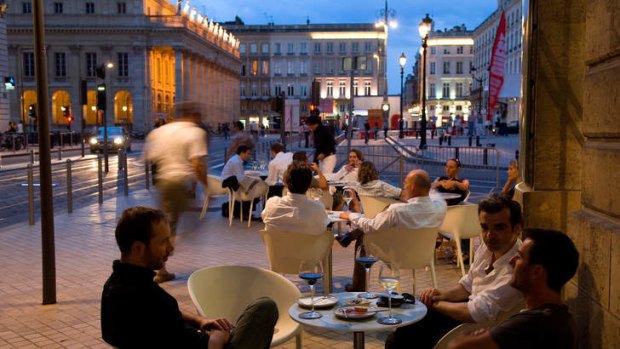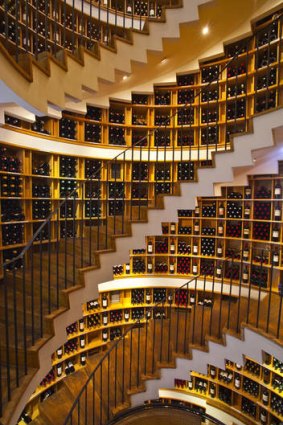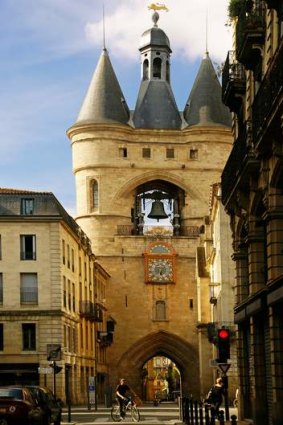
The city's enviable riverside area, classified as World Heritage by UNESCO.Credit: Alamy
It was the Romans who brought vines to Bordeaux. Then look what happened, writes Paul Byrnes.
Take a fine wine glass, a corkscrew and one of the 970 million bottles of wine Bordeaux produces annually. Open it, sniff it and pour a decent measure, because the following is best read with a red.
Bordeaux is beautiful and I'm not just talking about the wine. The city itself is a knockout and has been astonishing visitors since the 18th century, when the mediaeval town was modernised with 5000 new buildings. These stretch for several kilometres along the riverfront as a defiant symbol of prestige and wealth. They proclaim this city is not provincial (even if it is). These streets are built on wine, almost literally, because many of the cellars used by wine brokers (here called negociants) are beneath the footpaths. On the Quai des Chartrons, for hundreds of years the centre of the wine trade, some cellars go back hundreds of metres. You can see one at the Musee Du Vin.

L'intendant wine shop in Bordeaux.Credit: Corbis
In fact, two trades paid for this boom, one of them not so lovely. Bordeaux doesn't like to discuss it but slavery paid for the other half, as Bordeaux was one of the main ports in the triangular trade between Africa, the New World and France. The slaves never saw Bordeaux but hundreds of ships from here took part in their transportation.
Bordeaux's beautiful buildings are reminiscent of Paris, a city that Bordeaux both resembles and resents. That rivalry is a defining characteristic of the place, au bord de l'eau (at the edge of the water). Bordeaux is the little sister to the capital. Three times during war, the French government has relocated to Bordeaux. That's partly because Bordeaux feels like Paris without the attitude, the rude taxi drivers and the noise (or in those cases, the Germans). It is friendlier and warmer and as of recent years, cleaner.
The city now looks like it was just completed, part of the campaign of beautification begun by the energetic and ambitious Alain Juppe, who was first elected mayor in 1995. He became prime minister under Jacques Chirac's administration and foreign minister under Nicolas Sarkozy - and suffered a scandalous conviction for misuse of public funds. The Bordelais didn't care: they re-elected Juppe in 2001, 2006 and 2008 because he restored their city's pride. In June, 2007, the historic centre of Bordeaux was added to UNESCO's World Heritage list. Take that, Paris.

Vintage town: Bordeaux's Grosse Cloche bell tower and the former St Eloi town gate.Credit: Alamy
Bordeaux has always had a sense of independence. When Eleanor of Aquitaine married Henry Plantagenet, the Duke of Normandy, in 1152, Aquitaine came as her dowry. Two years later, Henry became king of England. The English kings developed a taste for the main product of Bordeaux, which they called "claret". King John even exempted the trade from taxes.
Victor Hugo wrote in 1843 that Bordeaux was "curious, original, perhaps unique. Take Versailles, add Antwerp, and you have Bordeaux". In fact, you don't. Neither has the Garonne, from which all good things flow. The river is key to Bordeaux's success.
Bordeaux is 60 kilometres inland but the Garonne meets the Dordogne river a few kilometres north of the town. From here it's called the Gironde and the access to the sea has allowed shipping merchants to buy wine for almost 2000 years. Pliny the Elder wrote about Bordeaux's vineyards in AD71. The Romans took Bordeaux wine to Britain for their own use - beginning a beautiful friendship.
In the early 14th century, Bordeaux exported the equivalent of 110 million bottles a year to Britain, according to Nicholas Faith's lively history, The Winemasters of Bordeaux. Half of this went to England, which had only four million people, most of whom could not afford wine. Those who could afford to drank vast quantities, bought from the 300 wine merchants in the City of London. There is a direct line between those cellars and those under the Quai des Chartrons in Bordeaux, where the negociants blended from growers and shipped it to Britain. The British merchants adulterated and "improved" it with heavier Spanish plonk or fortifying spirits. Great fortunes were made by destroying the taste of Bordeaux for British palates. Funnily enough, no one minded - Bordeaux wines were not that special anyway.
The areas that now produce the extraordinary quality of a Chateau Lafite Rothschild, a Margaux, a Latour or a Mouton Rothschild were not even planted with vines. These all come from an exalted strip of land on the left bank of the Garonne above Bordeaux, the Medoc.
This is the most famous terroir in the world, the foundation of Bordeaux's wealth and fame as a modern wine producer, but no-one grew wine there until 300 years ago. It was too marshy and the Bordelais resisted all attempts to build a road along this side of the river. They didn't want their competitors from other regions bypassing Bordeaux and shipping direct to English markets through the small ports at Pauillac and Lamarque.
A lot can change in 300 years. The Medoc now produces the best and most expensive red wines in the world. In fact, highest quality Bordeaux is ridiculously expensive. Is it possible then to visit Bordeaux and actually taste these $1000-a-bottle wines? Yes it is. My favourite bar in Bordeaux has 48 wine vacuum machines, where the top wines may be tasted in good conditions (see box). All you need is money, lots of it.
A splash of Lafite in your glass will cost around €30 ($42) but you will know what the fuss is all about. You will be poorer but happier. That could be the motto of Bordeaux, the place that turns sunshine into liquidity.
How to taste the good stuff
In 1855, Emperor Napoleon III asked the wine brokers of Bordeaux to rank their best wines by quality for the Exposition Universelle de Paris.
The merchants came up with five tiers. There were four estates in the top rank (now five), known now as the "first growths" (crus). There were 12 in the second and so on through five tiers. These were just the reds.
The sweet whites of Sauternes got their own classification. The right-bank wines of St-Emilion and Pomerol, some of which now outrank almost everything on the left bank, were ignored.
St-Emilion set up its own complex classification system and Pomerol has refused to do so. (If you want to understand Bordeaux wines, you are going to have to do some study, as well as drinking.)
The upshot of the 1855 classification, which has remained almost unchanged, is that some estates became very rich indeed and very haughty. That means you cannot just rock up for a visit.
A trip to the Medoc is one of the great pleasures of a visit to Bordeaux but you must book in advance - and we're talking months ahead - to get into the top estates. Thankfully, there are many smaller, more welcoming chateaux, such as Chateau Kirwan (a third growth) on the left bank, or Chateau Figeac in St-Emilion.
The Bordeaux tourist office can help set up a visit or you can take a wine tour, or hire a personal guide.
Tasting the best is possible but expensive. At Max Bordeaux, which calls itself a wine gallery (14 Cours de L'Intendance), 48 top wines are available through vacuum dispensing machines.
You can blow $100 in 30 minutes, but it will be a memorable half hour!
They also have some of the big estates' "second" wines - made the same way, but from younger vines, and much cheaper. They will ship to Australia and you can buy in bond (before a wine is released, based on expert evaluations of its quality).
The Musee du Vin at 41 Rue Borie has typical cellars and knowledgeable guides.
See mvnb.fr.
TRIP NOTES
GETTING THERE
Emirates has a fare to Paris for about $1730 low-season return from Sydney and Melbourne including tax. Fly to Dubai (about 14hr) and then to Paris (7hr 10min). Phone 1300 303 777, see emirates.com. This fare allows you to fly to Dubai via another Asian city and to fly back from another European city. Fast TGV trains travel daily between Paris (Gare Montparnasse, 14th arron-dissement) and Bordeaux Saint Jean. Travel time is about 3hr. Bordeaux's Merignac Airport is a 30-minute drive from the city centre.
STAYING THERE
On a budget The just-opened Mama Shelter, part of a funky, cheap, designer chain, has rooms from €89 ($126) a night. See mamashelter.com/en/bordeaux.
Luxury The Grand Hotel de Bordeaux has one of the city's best restaurants, Le Pressoir d'Argent. Rooms from €261 a night for two people. See ghbordeaux.com.
DINING THERE
A trip to La Tupina is a must. See latupina.com. For a two Michelin star experience, try the Hostellerie de Plaisance in St-Emilion. See hostellerie-plaisance.com.
MORE INFORMATION
Sign up for the Traveller Deals newsletter
Get exclusive travel deals delivered straight to your inbox. Sign up now.